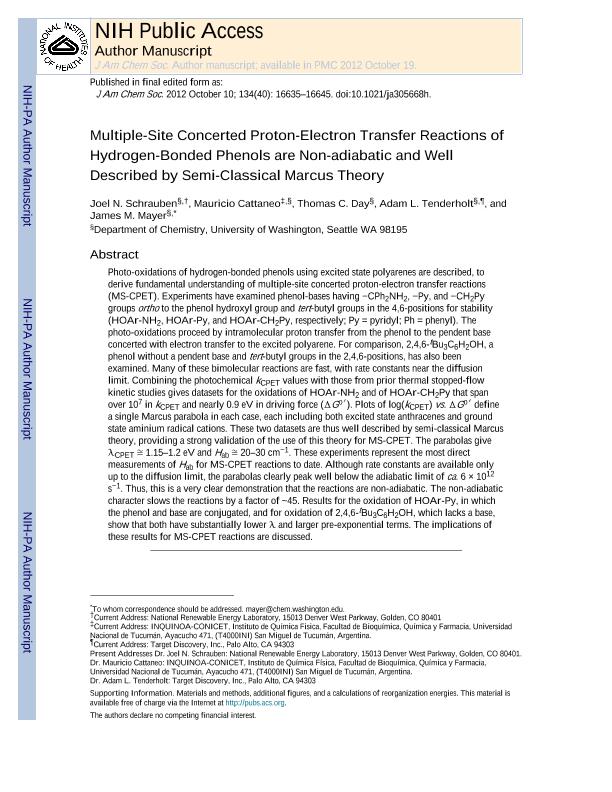Artículo
Multiple-site concerted proton-electron transfer reactions of hydrogen-bonded phenols are nonadiabatic and well described by semiclassical marcus theory
Fecha de publicación:
10/2012
Editorial:
American Chemical Society
Revista:
Journal of the American Chemical Society
ISSN:
0002-7863
Idioma:
Inglés
Tipo de recurso:
Artículo publicado
Clasificación temática:
Resumen
Photo-oxidations of hydrogen-bonded phenols using excited-state polyarenes are described to derive fundamental understanding of multiple-site concerted proton-electron transfer reactions (MS-CPET). Experiments have examined phenol bases having -CPh2NH2, -Py, and -CH2Py groups ortho to the phenol hydroxyl group and tert-butyl groups in the 4,6-positions for stability (HOAr-NH2, HOAr-Py, and HOAr-CH2Py, respectively; Py = pyridyl; Ph = phenyl). The photo-oxidations proceed by intramolecular proton transfer from the phenol to the pendent base concerted with electron transfer to the excited polyarene. For comparison, 2,4,6- tBu3C6H2OH, a phenol without a pendent base and tert-butyl groups in the 2,4,6-positions, has also been examined. Many of these bimolecular reactions are fast, with rate constants near the diffusion limit. Combining the photochemical kCPET values with those from prior thermal stopped-flow kinetic studies gives data sets for the oxidations of HOAr-NH2 and HOAr-CH2Py that span over 107 in kCPET and nearly 0.9 eV in driving force (ΔGo′). Plots of log(kCPET) vs ΔG o′, including both excited-state anthracenes and ground state aminium radical cations, define a single Marcus parabola in each case. These two data sets are thus well described by semiclassical Marcus theory, providing a strong validation of the use of this theory for MS-CPET. The parabolas give λCPET 1.15-1.2 eV and Hab 20-30 cm-1. These experiments represent the most direct measurements of Hab for MS-CPET reactions to date. Although rate constants are available only up to the diffusion limit, the parabolas clearly peak well below the adiabatic limit of ca. 6 × 1012 s-1. Thus, this is a very clear demonstration that the reactions are nonadiabatic. The nonadiabatic character slows the reactions by a factor of ∼45. Results for the oxidation of HOAr-Py, in which the phenol and base are conjugated, and for oxidation of 2,4,6-tBu3C6H2OH, which lacks a base, show that both have substantially lower λ and larger pre-exponential terms. The implications of these results for MS-CPET reactions are discussed.
Palabras clave:
Electron Transfer
,
Proton Transfer
,
Marcus Theory
,
Pcet
Archivos asociados
Licencia
Identificadores
Colecciones
Articulos(INQUINOA)
Articulos de INST.DE QUIMICA DEL NOROESTE
Articulos de INST.DE QUIMICA DEL NOROESTE
Citación
Schrauben, Joel N.; Cattaneo, Mauricio; Day, Thomas C.; Tenderholt, Adam L.; Mayer, James M.; Multiple-site concerted proton-electron transfer reactions of hydrogen-bonded phenols are nonadiabatic and well described by semiclassical marcus theory; American Chemical Society; Journal of the American Chemical Society; 134; 40; 10-2012; 16635-16645
Compartir
Altmétricas




